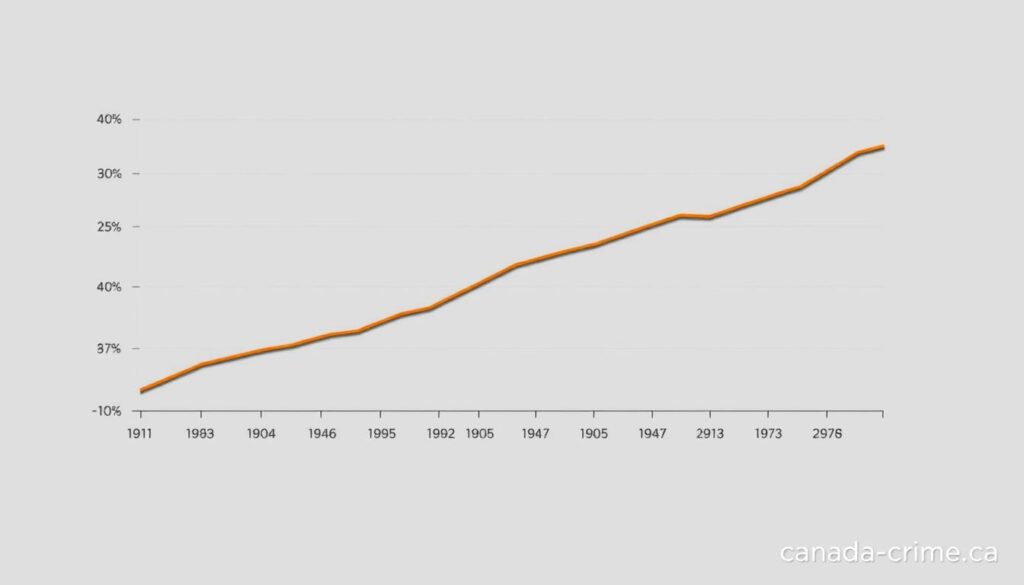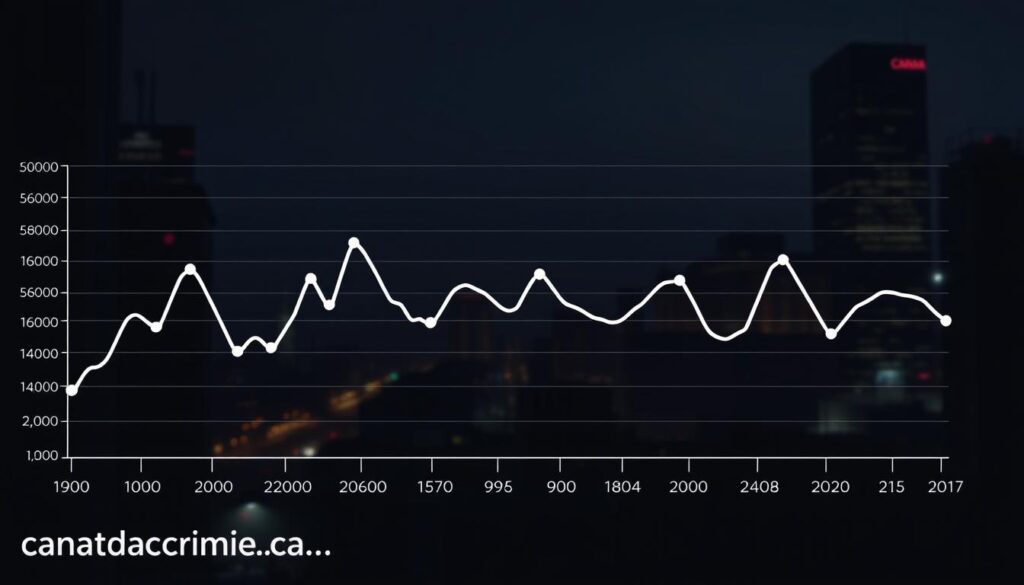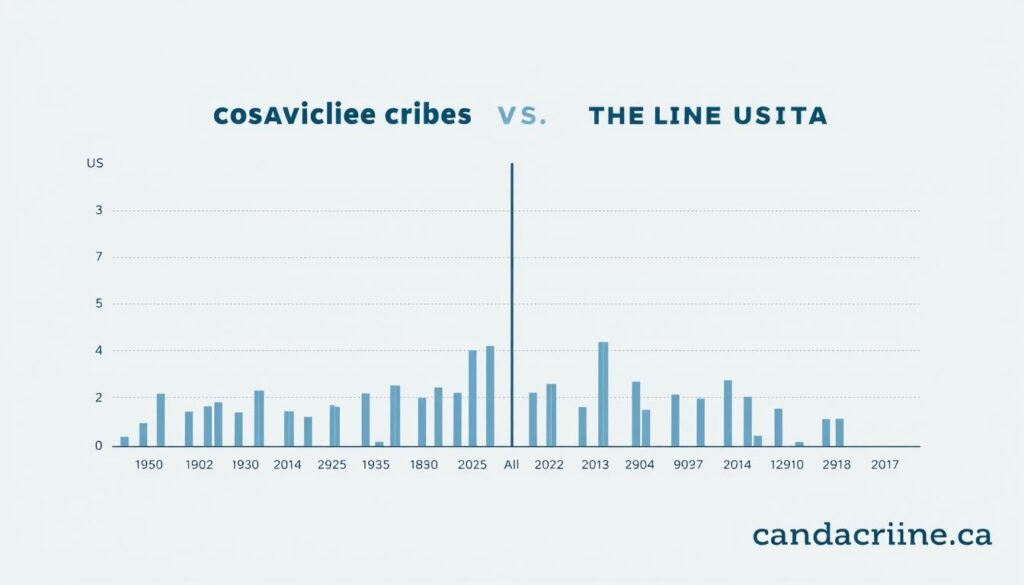Canada has seen a notable shift in its crime trends over the past few decades. According to Statistics Canada, after a steady decline since the late 1990s, the Crime Severity Index (CSI) rose by 2% in 2023, marking the third consecutive year of increase.
This uptick in crime rates has sparked interest in understanding the current state of public safety across the country. The analysis will delve into the statistics and data surrounding various categories of crimes, their prevalence, and their impact on different provinces and territories.
By examining the most recent data from authoritative sources, including Statistics Canada, this article aims to provide insights into the evolving nature of crime trends in Canada, offering a comprehensive understanding for policymakers, law enforcement, and citizens alike.
Current Violent Crime Trends in Canada
Recent data from Statistics Canada reveals a nuanced picture of violent crime trends across the country. While some categories of violent crime are showing signs of decline, others are experiencing an unsettling increase.
Crime Severity Index Overview
The Crime Severity Index (CSI) is a critical tool for understanding the complexity of crime in Canada. It measures both the volume and severity of crime, providing a more comprehensive picture than crime rates alone. The overall CSI has seen fluctuations, reflecting changes in both violent and property crimes. The index is calculated based on the number of incidents reported to the police, with different crimes weighted according to their seriousness.

Recent Statistical Developments
In 2023, the police-reported crime rate per 100,000 people was 5,843, marking a 2.5% annual change from the previous year. Homicide figures showed a welcome decline, with 778 victims, representing 104 fewer cases than in 2022. However, gang-related homicides still account for approximately one-quarter of all homicides. On the other hand, police-reported hate crimes have seen a troubling 32% increase, reaching 4,777 incidents in 2023. The data indicates a complex picture of public safety across different population centers.
According to Statistics Canada, “The number of police-reported hate crimes was 4,777, a 32% increase from 2022, with crimes targeting a religion or a sexual orientation accounting for most of the increase.” This rise in hate crimes is a concerning trend that warrants closer examination and action.
- The police-reported crime rate per 100,000 people was 5,843 in 2023.
- Homicide victims decreased to 778 in 2023, down 104 from 2022.
- Police-reported hate crimes increased by 32% to 4,777 incidents.
Understanding Violent Crime Rate Canada
Understanding the violent crime rate in Canada involves delving into the definitions, classifications, and measurement methodologies used. The crime severity index plays a crucial role in this analysis, providing a weighted measure of crime rates based on the seriousness of the offenses.
Definition and Classification of Violent Crimes
Violent crimes in Canada are defined and classified based on their severity and impact. The crime severity index is a critical tool in this classification, as it weights crimes according to their seriousness. The Violent Crime Severity Index recorded a value of 99.5 in 2023, indicating a minimal change from the previous year.
The classification of violent crimes considers the number of incidents and their impact on the population. For instance, crimes such as homicide and assault are given more weight due to their severe nature. This approach allows for a more nuanced understanding of crime trends across different areas and populations.
Measurement Methodologies
Canada employs two primary methodologies to measure crime: the traditional Crime Rate and the Crime Severity Index (CSI). The Crime Rate counts the number of criminal incidents per 100,000 population, while the CSI weights crimes according to their seriousness based on actual sentences handed down by courts.

Statistics Canada collects crime data through the Uniform Crime Reporting (UCR) Survey, covering 99% of the Canadian population. The data collection process includes both police-reported crime statistics and victimization surveys, providing a comprehensive view of crime rates.
| Measurement Methodology | Description | 2023 Value |
|---|---|---|
| Crime Rate | Number of criminal incidents per 100,000 population | 5,843 |
| Violent Crime Severity Index | Weighted measure of violent crimes based on seriousness | 99.5 |
| Non-violent Crime Severity Index | Weighted measure of non-violent crimes based on seriousness | 73.5 |
Regional Analysis of Violent Crime in Canada
Canada’s vast geography encompasses diverse crime patterns, with significant regional variations in violent crime rates. Understanding these differences is crucial for developing effective crime prevention strategies.
Provincial and Territorial Crime Rate Comparisons
Crime statistics vary considerably across different parts of Canada. Generally, the eastern provinces have the lowest violent crime rates, while the western provinces have higher rates, and the territories have the highest rates. Manitoba and Saskatchewan are notable for having the highest violent crime rates among the provinces.
| Province/Territory | Violent Crime Rate |
|---|---|
| Manitoba | High |
| Saskatchewan | High |
| British Columbia | Moderate |
| Ontario | Low |
Urban vs. Rural Crime Patterns
Urban and rural areas in Canada exhibit distinct crime patterns. Certain types of violent crimes are more prevalent in urban centers, while others occur more frequently in rural communities. For instance, major metropolitan areas like Toronto, Montreal, and Vancouver have unique crime profiles. Toronto reported a Violent Crime Severity Index of 46.2 in 2020, significantly lower than the national average. For more detailed information on Canada’s crime rates, visit Canada Crime Rates.
Rural communities often face challenges related to police response times due to geographical distances, affecting both crime rates and reporting patterns. Property crimes also show different distribution patterns, with urban areas experiencing higher rates of theft and break-ins, while rural areas may see more agricultural property crimes.

Historical Trends in Canadian Violent Crime
The historical trends in Canadian violent crime reveal a complex interplay of social, economic, and legislative factors. Understanding these trends is essential for developing effective crime prevention strategies.
Long-term Statistical Patterns
Over the years, Canada has witnessed fluctuations in its violent crime rate. Recent data indicates that the Crime Severity Index (CSI) rose by 2% in 2023, marking the third consecutive year of increase. This trend is influenced significantly by increases in reported fraud, extortion, and child pornography cases, which soared by 52% in 2023. Fraud, in particular, has seen a significant rise, increasing by 46% between 2008 and 2018. These changes reflect broader shifts in criminal activity and law enforcement priorities.

Factors Influencing Crime Rate Changes
Multiple factors contribute to changes in Canadian crime rates. Demographic shifts, particularly in the youth population, play a significant role in youth crime rates. Economic factors, such as unemployment rates and income inequality, also correlate with certain types of property and violent crime. Legislative and policy changes impact both actual crime rates and how crimes are reported and recorded. Furthermore, technological advancements have created new criminal opportunities, such as cybercrime, while reducing others, like motor vehicle theft, due to improved security features. Social factors, including substance abuse patterns and community cohesion, also significantly influence crime rate changes.
The interplay of these factors underscores the complexity of addressing crime in Canada. By understanding these historical trends and factors, policymakers can develop more effective strategies for preventing violent crime and improving public safety.
Canada vs. International Crime Rates
Canada’s global ranking in terms of crime rates is a topic of interest, reflecting its safety and security relative to other nations. According to the Institute for Economics & Peace Global Peace Index, Canada is ranked the 11th safest country out of 163 countries, indicating a relatively low crime rate compared to many other nations.
Canada-US Crime Rate Comparison
One of the most relevant comparisons for Canada is with its neighbor, the United States. Canada’s homicide rate is significantly lower than that of the US, with rates 2.7 times lower. This comparison highlights the differences in violent crime rates between the two countries, with Canada having a more favorable ranking. The homicide rate per 100,000 population is a key statistic used in these comparisons.

Global Positioning of Canadian Crime Rates
Globally, Canada’s crime rates are positioned favorably, especially when compared to other developed nations. While Canada ranks 95th in terms of homicide rate globally, it is considered relatively safe compared to many countries. However, its ranking is not as favorable when compared to other developed nations like Australia, England, France, and Ireland. The table below summarizes Canada’s global positioning in terms of crime rates.
| Crime Rate Category | Canada’s Global Ranking | Rate per 100,000 Population |
|---|---|---|
| Homicide Rate | 95th | 1.95 |
| Violent Crime Rate | 11th (safest) | 740.8 |
| Overall Crime Rate | Not Ranked | Not Available |
Preventing Violent Crime in Canada
Preventing violent crime in Canada requires a multifaceted approach that involves various stakeholders and strategies. Effective crime prevention not only reduces the incidence of crime but also enhances community safety and trust in the justice system.
Current Prevention Strategies
Canada employs a range of strategies to prevent violent crime, including community-based programs and law enforcement initiatives. Youth-focused policing initiatives aim to divert young offenders from the criminal justice system through restorative justice programs and community-based interventions. Additionally, specialized units address specific crime types such as gang violence, domestic abuse, and motor vehicle theft.
The use of data-driven approaches is also a key component of current prevention strategies. By analyzing crime statistics and patterns, law enforcement agencies can allocate resources more effectively to high-crime areas and times, thereby preventing both property and violent crimes.
Law Enforcement Approaches
Law enforcement approaches to crime prevention in Canada vary by jurisdiction, with the Royal Canadian Mounted Police (RCMP) serving as the national police force while provinces and municipalities maintain their own services. Canada maintains a relatively low ratio of police officers to population, with significant regional variations.
| Region | Persons per Police Officer |
|---|---|
| Nunavut | 247.9 |
| Northwest Territories | 248.5 |
| Yukon | 258.2 |
| Newfoundland and Labrador | 664.9 |

Conclusion
The Violent Crime Severity Index serves as a crucial metric for understanding the changing nature of crime in Canada. Recent trends indicate a concerning increase in crime rates since 2015, following a long period of decline. Regional disparities are significant, with areas like the Northwest Territories experiencing much higher crime rates than the national average.
Effective crime prevention requires collaboration between government, law enforcement, and community organizations, informed by high-quality statistical data. While Canada maintains a relatively favorable global crime ranking, recent upward trends signal the need for renewed attention to crime prevention strategies and addressing underlying social factors.

